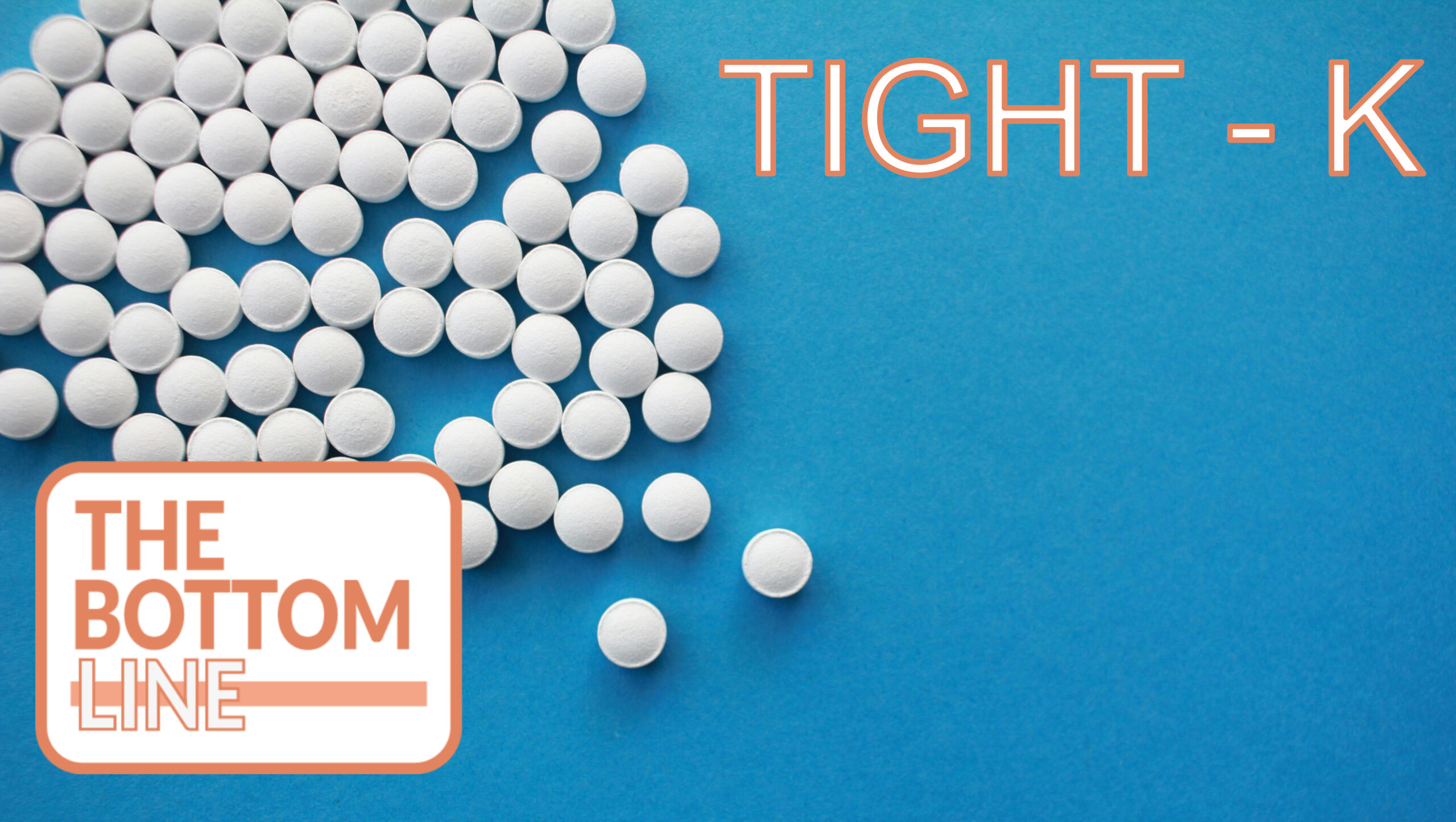TIGHT K: Potassium Supplementation and Prevention of Atrial Fibrillation After Cardiac Surgery
Potassium Supplementation and Prevention of Atrial Fibrillation After Cardiac Surgery: The TIGHT K Randomized Clinical Trial
O’Brien. JAMA 2024; 332:979 – 988. doi:10.1001/jama.2024.17888
Clinical Question
- In adult patients undergoing coronary artery bypass surgery (CABG) is supplementing potassium when serum concentration is ≤ 3.5 mEq/L non-inferior to supplementation when serum concentration is ≤ 4.5 mEq/L to reduce the frequency of new onset atrial fibrillation?
Background
- New-onset atrial fibrillation after cardiac surgery (AFACS) is common affecting up to a third of patients
- It is associated with short and long-term morbidity and mortality
- Potassium supplementation is a widely strategy to prevent and treat AFACS, with many centers targeting a high-normal serum concentration (>4.5 mEq/L)
- There is a limited evidence base to support this practice
Design
- Prospective RCT
- Randomised in 1:1 ratio using website
- Block sizes of 4 and 6 with stratification by site
- Written informed consent from all patients
- Primary outcome was occurrence of new-onset AFACS within first 120 hours
- This could be atrial fibrillation, atrial flutter or other atrial tachyarrhythmia lasting > 30 seconds and confirmed clinically and electrocardiographically
- AFACS detected using standard monitoring or ambulatory heart rate monitors
- Trial treatment period was first 120 hours post-surgery
- All clinically detected events and ambulatory monitors analysed by independent event validation committee
- Event validation committee and laboratory analysing ambulatory heart rate monitors were blinded
- Non-inferiority trial
- Non-inferiority margin set at an absolute risk difference of less than 10% (upper bound of 1 sided 97.5% confidence interval)
- 1514 patients needed to provide 90% power to detect non-inferiority assuming a 35% prevalence in tightly controlled group
- Sample size inflated to 1684 allowing a 10% loss to follow up
- Non-inferiority margin deemed clinically relevant and feasible by experts, caregivers and patient representatives
- Intention to treat analysis
Setting
- 23 cardiac surgical centres in UK (n = 21) and Germany (n = 2)
- Enrollment from October 2020 until November 2023
Population
- Inclusion:
- > 18 years old
- Isolated CABG surgery
- Exclusion:
- Prior history of AF
- High grade AV block
- Current or previous use of medications for cardiac rhythm management
- K+ > 5.5 mEq/L
- Dialysis dependence
- 5568 assessed of which 1690 randomised
- 843 to relaxed group
- 844 to tight group
- Comparing baseline characteristics of relaxed vs. tight group
- Age: 65 vs 65
- Male: 83 vs 86%
- EuroSCORE II: 1.5 vs 1.6
- Beta-blocker at baseline: 79 vs 77%
- Cardiopulmonary Bypass: 87 vs 85%
- Rates of CKD, diabetes, previous cerebrovascular event and use of ACE inhibitors, loop diuretics and statins similar
Intervention
- Relaxed control
- Only supplementing K+ when serum concentration ≤ 3.5 mEq/L
- Mean K+ level ~ 4.4 on day 1 to ~4.1 on day 5
Control
- Tight control
- Supplementing K+ when serum concentration ≤ 4.5 mEq/L
- Mean K+ level ~ 4.6 on day 1 to 4.3 on day 5
Management common to both groups
- Serum K+ measured using laboratory and point of care devices
- Route of administration according to local protocols
- All other treatments including beta blockade and magnesium given according to local standard care
Outcome
- Primary outcome:
- Development of new-onset AFACS
- 231/830 [27.8%] in relaxed group vs 219/837 [26.2%] in tight group
- Unadjusted risk difference 1.7% (95% CI -2.6% to 5.9%)
- Upper bound of CI lies within 10% so therefore non-inferiority criteria met
- No difference in any subgroup (including age, sex, AF during surgery, beta-blockade at baseline, ejection fraction, bypass status)
- Secondary outcomes:
- No significant difference in
- Dysrhythmias other than atrial fibrillation (19.1 vs 21.1%)
- In-patient mortality (6.2 per 10000 inpatient days in both groups)
- Time to ICU discharge (2 vs 2 days)
- Time to hospital discharge (6 vs 6 days)
- Significantly less in relaxed group
- Mean Total Costs (USD):
- $39.30 vs $151.19
- Mean difference of $111.89 (95% CI 103.60 – 120.19)
- Mean Total Costs (USD):
- No significant difference in
Authors’ Conclusions
- Supplementing potassium only when serum concentrations fell ≤ 3.5 mEq/L was non-inferior to supplementing potassium to maintain a serum potassium of ≥ 4.6 mEq/L
Strengths
- Randomised, multi-site trial
- Well balanced baseline characteristics
- Minimal loss to follow up
- Similar use of beta-blockers, amiodarone and magnesium (eTable 3) between groups
- Similar number of potassium measurements in each group (eTable 8)
- Achieved separation in frequency of K+ administration (Figure 3A) with a median of 0 and 7 administrations in relaxed and tight groups respectively
- Use of ambulatory devices to increase AFACS detection rate
- Cost analysis
- This can’t necessarily be extrapolated to other sites as based on data sourced from Barts Health NHS Trust
- Patient and consumer representation on outcome design
Weaknesses
- Open label
- Other types of cardiac surgical procedures not included
- Higher rates of protocol nonadherence in tight group (135 vs 48)
- Per-protocol analysis similar to intention to treat analysis
- Whilst frequency of potassium supplementation was higher in tight group, serum K+ concentrations were both > 4 mEq/L throughout in both groups (Figure 3B)
- Whilst the purpose of the trial was to assess thresholds for supplementation, there was no data reported on the use of drugs such as loop diuretics which could interfere with homeostasis of serum potassium levels
- These results may not be applicable if serum concentrations are under < 4 mEq/L
The Bottom Line
- This trial provides high quality evidence to answer a question that anyone working in a cardiac ICU faces on a daily basis and I will be less aggressive with my routine practice to target a potassium level > 4.5 mEq/L
- Not only are there cost implications but reduction in use of electrolyte replacement (in particular intravenous) will also have environmental benefits
External Links
Metadata
Summary author: George Walker @hgmwalker89
Summary date: 6th October 2024
Peer-review editor: David Slessor
Picture by: Hal Gatewood / Unsplash




